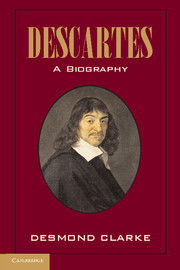Book contents
- Frontmatter
- Contents
- Preface and Acknowledgments
- Note on Texts and References
- Descartes Family Tree
- Introduction
- 1 A Lawyer's Education
- 2 In Search of a Career (1616–1622)
- 3 Magic, Mathematics, and Mechanics: Paris, 1622–1628
- 4 A Fabulous World (1629–1633)
- 5 The Scientific Essays and the Discourse on Method (1633–1637)
- 6 Retreat and Defence (1637–1639)
- 7 Metaphysics in a Hornet's Nest (1639–1642)
- 8 The French Liar's Monkey and the Utrecht Crisis
- 9 Descartes and Princess Elizabeth
- 10 The Principles of Philosophy (1644)
- 11 The Quarrel and Final Rift with Regius
- 12 Once More into Battle: The Leiden Theologians (1647)
- 13 Thoughts of Retirement
- 14 Death in Sweden
- Appendix 1 Descartes' Principal Works
- Appendix 2 Places Where Descartes Lived
- Notes
- Bibliography
- Index
7 - Metaphysics in a Hornet's Nest (1639–1642)
Published online by Cambridge University Press: 18 July 2009
- Frontmatter
- Contents
- Preface and Acknowledgments
- Note on Texts and References
- Descartes Family Tree
- Introduction
- 1 A Lawyer's Education
- 2 In Search of a Career (1616–1622)
- 3 Magic, Mathematics, and Mechanics: Paris, 1622–1628
- 4 A Fabulous World (1629–1633)
- 5 The Scientific Essays and the Discourse on Method (1633–1637)
- 6 Retreat and Defence (1637–1639)
- 7 Metaphysics in a Hornet's Nest (1639–1642)
- 8 The French Liar's Monkey and the Utrecht Crisis
- 9 Descartes and Princess Elizabeth
- 10 The Principles of Philosophy (1644)
- 11 The Quarrel and Final Rift with Regius
- 12 Once More into Battle: The Leiden Theologians (1647)
- 13 Thoughts of Retirement
- 14 Death in Sweden
- Appendix 1 Descartes' Principal Works
- Appendix 2 Places Where Descartes Lived
- Notes
- Bibliography
- Index
Summary
There are few people who can understand metaphysics.
At the beginning of the year 1640, Descartes was still living in Santpoort. He had given up the idea of publishing a selection of objections and replies to the Essays, and had been working instead for some weeks on what he described as ‘An Essay on Metaphysics’. Although this was not his first incursion into metaphysics, it represented a significant departure from what he had been doing during the previous decade and a return to a project that had been deferred since 1629. In that year he had written to Father Gibieuf, a theologian and member of the Oratory in Paris, that he would hold him to his promise to correct ‘a little treatise’ that he hoped to complete within two or three years. Descartes had evidently intended to contribute to the anti-libertine literature, in which the names of Mersenne and Garasse were so prominent, and to write about atheism and the human soul. The following year, 1630, he told Mersenne that he had worked on almost nothing apart from metaphysics for nine months after arriving in the United Provinces – adding, on that occasion, that it would not be appropriate to publish anything about metaphysics until he first saw how his projected book on physics was received.
Since his ‘physics’ [i.e., The World] was never published, he had no indication from its success or otherwise of how his metaphysical speculations might be received when he returned to the project in 1639.
- Type
- Chapter
- Information
- Descartes: A Biography , pp. 184 - 217Publisher: Cambridge University PressPrint publication year: 2006



